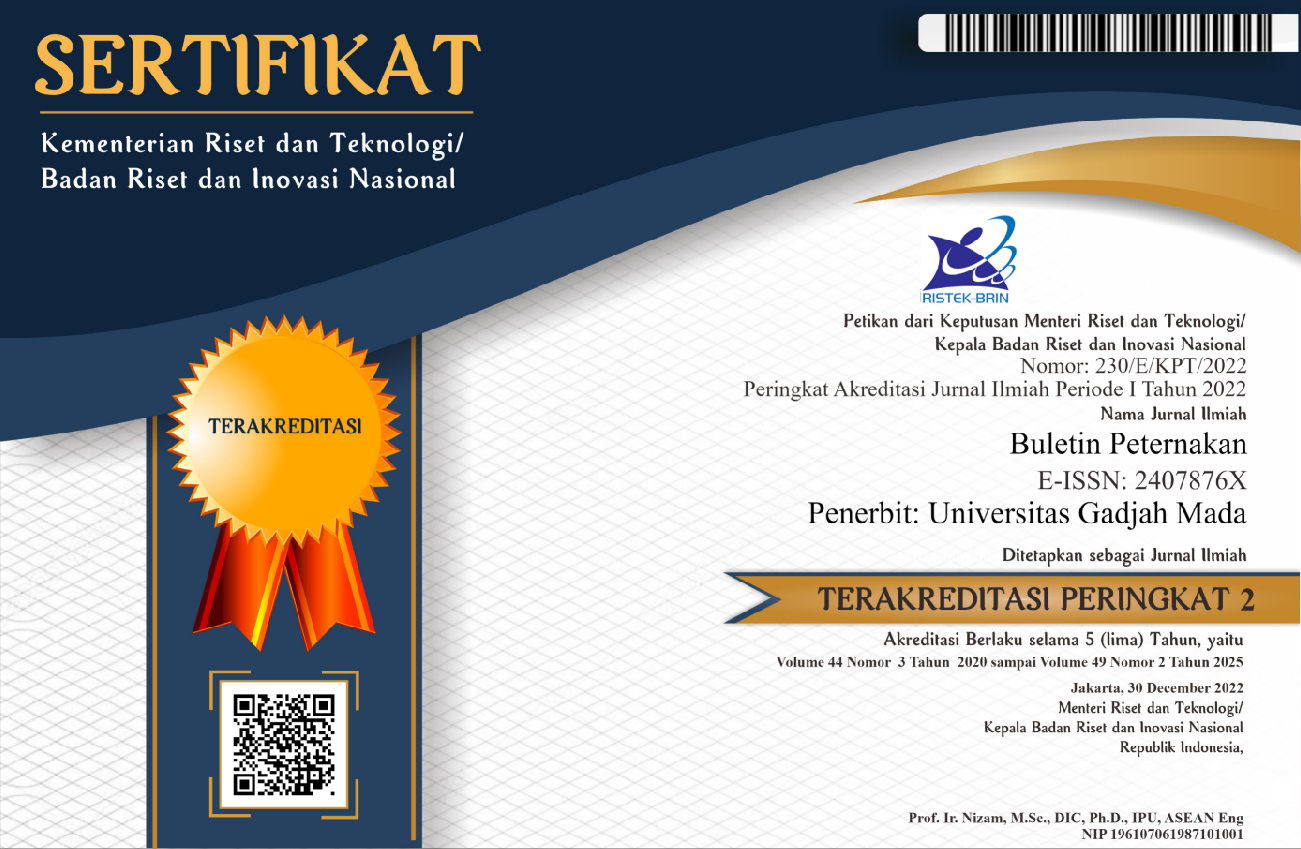In Vitro Antibacterial Activity of Black Soldier Fly (Hermetia Illucens) Larva Extracts Against Gram-Negative Bacteria
Harlystiarini Harlystiarini(1), Rita Mutia(2), I Wayan Teguh Wibawan(3), Dewi Apri Astuti(4*)
(1) Department of Nutrition and Feed Science, Faculty of Animal Science, Bogor Agricultural University, Bogor, 16680, Indonesia
(2) Department of Nutrition and Feed Science, Faculty of Animal Science, Bogor Agricultural University, Bogor, 16680, Indonesia
(3) Department of Nutrition and Feed Science, Faculty of Animal Science, Bogor Agricultural University, Bogor, 16680, Indonesia
(4) Department of Nutrition and Feed Science, Faculty of Animal Science, Bogor Agricultural University, Bogor, 16680, Indonesia
(*) Corresponding Author
Abstract
The aim of this study was to evaluate the in vitro antibacterial activity of Black soldier fly (BSF) larva extract. The BSF larva was extracted using methanol and then tested for antibacterial activity using agar diffusion method (zone growth inhibition). The antibacterial activity was conducted against Salmonella sp. and Escherichia coli, two important bacterial strains in poultry, using six dilution levels (10 mg/ml, 20 mg/ml, 40 mg/ml, 80 mg/ml, 160 mg/ml and 320 mg/ml). All the results were subjected analyze using t-test method. Based on the diameter of the inhibition zone, the BSF larva extract has a strong (P<0.05) antibacterial activity against Salmonella sp. and E. coli when the concentration used 320 mg/ml. In addition, BSF larva extract also contain high amount of lauric acid (49.18%), a saturated fatty acid that has been proven to proposes as antibacterial agent. Therefore, it could be concluded that the BSF larva extract could be used as a candidate for antibacterial substances.
Keywords
Full Text:
PDFReferences
AOAC (Association of Official Analytical Chemist). 2012. Official Methods of Analysis. Association of Official Analytical Chemist, Wahshington.
AOAC (Association of Official Analytical Chemist). 2005. Official Methods of Analysis. Association of Official Analytical Chemist, Wahshington.
Brown, S. E., A. Howard, A. B. Kasprzak, K. H. Gordon, and P. D. East. 2008. The discovery and analysis of a diverged family of novel antifungal moricin-like peptides in the wax moth galler mellonella. Insect. Biochem. Mol. Bio. 38: 201–212.
Choi, W. H., J. H. Yun, J. P. Chu, and K. B. Chu. 2012. Antibacteriaal effect of extracts of Hermetia illucens (Diptera: Stratiomyidae) larvae against Gram-negative bacteriaa. Ento. Res. 42: 219–226. http://doi: 10.1111/j.1748-5967.2012.00465.x.
Diener, S., C. Zurbrügg, and K. Tockner. 2009. Conversion of organic material by BSF larvae–Establishing optimal feeding rates. Waste. Manag. Res. 27: 603-610. http://doi:10.1177/0734242X09103838.
Ganz, T. 2003. Defensins: antimicrobial peptides of innate immunity. Nat. Rev. Immunol. 3: 710–720.
Hazlett, L. and M. Wu. 2011. Defensins in innate immunity. Cell. Tissue. Res. 343: 175–188.
Hoffmann, J. A. and J. M. Reichhart. 2002. Drosophila innate immunity: an evolutionary perspective. Nature. Immunology. 3: 121–126.
Kim, S. A. and M. S. Rhee. 2016. Highly enhanced bacteriacidal effects of medium chain fatty acids (caprylic, capric, and lauric acid) combined with edible plant essential oils (carvacrol, eugenol, b-resorcylic acid, trans-cinnamaldehyde, thymol, and vanillin) against Escherichia coli O157:H7. Food. Control. 60: 447-454. http://doi: 10.1016/j.foodcont.2015.08.022.
Makkar, H. P. S., G. Tran, V. Heuzé, and P. Ankers. 2014. State of the art on use of insects in animal feed. Anim. Feed. Sci. Technol. 197: 1–33. http://doi: 10.1016/j.anifeedsci. 2014.07.008.
Marshall, B. M. and S. B. Levy. 2011. Food animals and antimicrobials: Impacts on Human Health. Clin. Microb. Rev. 24: 718–733.
Maurer, V., M. Holinger, Z. Amsler, B. Früh, J. Wohlfahrt, A. Stamer, and F. Leiber. 2015. Replacement of soybean cake by Hermetia illucens meal in diets for layers. JIFF. 1-8. http://doi 10.3920/JIFF2015. 0071.
Myers, H. M., J. K. Tomberlin, B. D. Lambert, and D. Kattes. 2008. Development of Black soldier fly (Diptera: Stratiomyidae) larvae fed dairy manure. Env. Ento. 37: 11-15.
Myers, N., R. A. Mittermeier, C. G. Mittermeier, G. A. B. da Fonseca, and J. Kent. 2000. Biodiversity hotspots for conservation priorities. Nature. 403: 853–858.
Pan, X., F. Chen, T. Wu, H. Tang, and Z. Zhao. 2009. The acid, bile tolerance and antimicrobial property of Lactobaccilus acidophillus NIT. J. Food. Control. 20: 598-602.
Park, S. I., J. W. Kim, and S. M. Yoe. 2015. Purification and characterization of a novel antibacteriaal peptide from Black soldier fly (Hermetia illucens) larvae. Dev. Comp. Immunology. 52: 98-106. http://doi: 10.1016/j.dci.2015.04.018.
Park, S. I., B. S. Chang, and S. M. Yoe. 2014. Detection of antimicrobial substances from larvae of the black soldier fly, Hermetia illucens (Diptera: Stratiomyidae). Ento. Res. 44: 58-64.
Steiner, T. and B. Syed. 2015. Phytogenic feed additives in animal nutrition. Á. Máthé (eds). Medicinal and Aromatic Plants of the World. p. 403-423. doi: 10.1007/978-94-017-9810-5_20.
Tsakas, S. and V. J. Marmaras. 2010. Insect Immunity and Its Signalling: An Overview. Department of Biology, University of Patras, Greece.
Yi, H. Y., M. Chowdhury, Y. D. Huang, and X. Q. Yu. 2014. Insect antimicrobial peptides and their application. Appl. Microbiol. Biotechnol. 05: 1-16. http://doi: 10.1007/s00253-014-5792-6.
Zasloff, M. 2002. Antimicrobial peptides of multicellular organisms. Nature. 415: 389-395.
Article Metrics
Refbacks
- There are currently no refbacks.

This work is licensed under a Creative Commons Attribution-ShareAlike 4.0 International License.
Buletin Peternakan (Bulletin of Animal Science) Indexed by:

This work is licensed under a Creative Commons Attribution-ShareAlike 4.0 International License.









